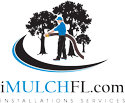
Florida Blown Mulch Installation Services
Bark mulch blowing provides a smooth and clean application of mulch to your Florida planting beds. It allows us to spread mulch on virtually any terrain such as steep slopes, hillsides, rooftops and inaccessible or remote areas up to 800 feet away. Most importantly, bark mulch blowing installation can save time and money.
Mulch insulates the base of your plants; keeping them warmer in the winter and cooler in the summer. Mulch helps to maintain the soil around your plants, and not all over your yard. Mulch is an easy and inexpensive way to add beauty of your residential or commercial landscaping, by providing a consistent color and texture throughout your landscape.
One of the most important attributes of mulching is the long-lasting affect it has on the health and protection of the soil, trees, plants and flowers it shields and safeguards. Mulch protects soil from baking and drying out, by altering the soil temperature and serving as an insulator to accommodate the surfaces needs in both summer and winter seasons. It also serves in the reduction of soil compaction by acting as a buffer layer from heavy rains, equipment and people. Mulching is extremely important in reducing the growth of weeds and other soil-borne diseases from intruding plants. Mulch also adds nutrients to the soil which helps improve the soil structure and plant growth. One of the best advantages of mulching is its ability to retain soil moisture allowing water to penetrate the soil, reduce evaporation, prevent erosion and drought and minimize the need for manual watering. This is especially crucial in times of dry weather and as an effort to reduce manual labor.
Make a long-term improvement for your business by choosing iMulchFL as your mulch installation vendor. Try us once and you will never want to go anywhere else.
Delicate landscapes can be easily accessed where heavy equipment, wheelbarrows or a crew could cause damage.
Hardwood, softwood, colored wood, and playground is all applied effortlessly, and the smooth, professional look is unrivaled. With the remote control, the volume of the output can be adjusted quickly to minimum flow for spreading around delicate flowers or turned up higher in more wide open areas. We can apply at least 20 to 50 yards per hour. No job is to large, if multiple trucks are needed we have the ability.
Wood or bark mulch is great around trees, shrubs, perennials, and small fruits. A wood/bark mulch creates a favorable environment for earthworms and soil microorganisms. Over time, this helps reduce soil compaction.
In perennial and shrub beds, wood/bark chips can reduce the need for irrigation by as much as 50%. Mulching materials that mesh together are more effective at reducing water evaporation from the soil. Under acute water restrictions, gardeners with wood/bark mulch have been incorrectly accused of illegally irrigating because their plants are still faring well, compared to the neighbors!
Wood/bark mulch is not recommended in vegetable or annual flowerbeds where the soil is routinely cultivated to prepare a seedbed.
When applied correctly, mulch has the following beneficial effects on plants and soil:
Mulch - General Use
Mulch Depth
How Deep To Apply Mulch?
The amount of mulch to apply depends on the texture and density of the mulch material. Many wood and bark mulches are composed of fine particles and should not be more than 2 to 3 inches deep. Excessive amounts of these fine-textured mulches can suffocate plant roots, resulting in yellowing of the leaves and poor growth.
Coarse-textured mulches such as pine bark nuggets allow good air movement through them and can be as deep as 4 inches.
The desired depth of wood/bark depends on size. Smaller size should not exceed a one to two inch depth. Larger size are typically applied at three to four inches deep. Thicker layers may reduce soil oxygen. Additional mulch needs to be added every few years to bring the mulch depth back to the desired amount.
With the larger size , three to four inches are needed for effective weed control and to eliminate the compaction forces of foot traffic. It is common to see where the mulch is too thin and does not provide for weed control and compaction management.
On compacted and/or clay soil, three to four inches of wood/bark may reduce water evaporation from the soil surface so much that susceptible plants develop root rots in wet years or under frequent irrigation.
In wet soil situations, mulching may be undesirable as it may help hold excessive water leading to root rots.
Where To Us Mulch?
Mulching is a very important practice for establishing new plantings, because it helps to conserve moisture in the root ball of the new plant until the roots have grown out into the surrounding soil. The growth rate and health of trees and shrubs increases when there is no competition for water and nutrients from weeds. Mulch also helps to prevent tree trunk injury by mowers and trimmers. Mulch entire beds of shrubs, trees, annuals, herbaceous perennials and ground covers.
Mulch can also be used to cover trails, driveways, and play and natural areas.
Mulch Around Trees
Wood/bark mulch is great for trees and shrubs, protecting trees from lawnmower damage. However, do not make “mulch volcanoes” around tree trunks by applying chips up against a tree’s trunk. Wet mulch piled up against the trunk can cause bark problems and interfere with the natural trunk taper, making the tree more prone to wind throw. Keep the mulch back at least 6” from the trunk.
When And How Often To Mulch?
The best time to mulch new plantings is right after you plant them. Around established plants mulch is best applied in early spring. This is when plants are beginning to grow and before weed seeds start to germinate.

